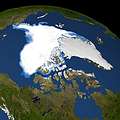 根據美國國家冰雪資訊中心(NSIDC)1日的報導,自1979年有衛星量測系統起,2007年北極冰圈在融冰季節降至最低點。北極冰圈後退的程度,使得西北通道在人類史上首度大開。
根據美國國家冰雪資訊中心(NSIDC)1日的報導,自1979年有衛星量測系統起,2007年北極冰圈在融冰季節降至最低點。北極冰圈後退的程度,使得西北通道在人類史上首度大開。
NSIDC資深科學家賽瑞茲(Mark Serreze)表示:「北極冰層一再惡性循環,將永遠無法回復原本狀態。年復一年,夏季融化的冰越來越多,而冬天凍結的冰則越來越少。在我們有生之年,北極圈的夏季可能看到無冰的景象。」NSIDC的科學家都認同,這種情況在2030年之前就會發生。
假設將衛星時代來臨前的船隻與飛機探測紀錄一起算進去,NSIDC的科學家指出,北極冰圈從1950年代起,已經下降50%之多。
造成此極度少冰現象原因之一,為在融冰季到來之前,冰層就已呈現薄弱狀態。NSIDC研究員史多福(Julienne Stroeve)說:「2007年春季的冰一開始就比往年來的少。較薄的冰層比較厚的冰層所需融解能量更低,故2007年夏季海冰降至最低點。」
加速2007年夏季冰層減少的另一因素為異常的大氣模式,在北極海上空出現頑固大氣高壓,而西伯利亞上空大氣壓較低。
科學家強調在高氣壓的影響之下天空會變得晴朗,有助強化融解。在此同時,高壓風將暖空氣又送進此區域。暖空氣再幫助進一步的冰層融化,並將冰層推離西伯利亞海岸。
在20世紀早期探險家眼裡,西北通道是一大障礙,2007年夏天則門戶大開。
1903年阿蒙森(Roald Amundsen)成為第一位成功航海通過這條水路的人。當時以2年半的驚人成績穿過此狹窄通道,並讓他們的船隻受困了2個嚴寒及黑暗的冬天。但如今2007年夏季的尾聲,一般船隻即可暢行無阻。
Arctic sea ice during the 2007 melt season sank to the lowest levels since satellite measurements began in 1979, according to a report released today by the National Snow and Ice Data Center. The Arctic sea ice receded so much that the Northwest Passage completely opened for the first time in human memory.
NSIDC Senior Scientist Mark Serreze said, "The sea ice cover is in a downward spiral and may have passed the point of no return. As the years go by, we are losing more and more ice in summer, and growing back less and less ice in winter. We may well see an ice-free Arctic Ocean in summer within our lifetimes." NSIDC scientists agree that this could occur by 2030.
If ship and aircraft records from before the satellite era are taken into account, the NSIDC scientists say, Arctic sea ice may have fallen by as much as 50 percent from the 1950s.
One factor that contributed to this fall's extreme decline was that the ice was entering the melt season in an already weakened state. NSIDC research scientist Julienne Stroeve said, "The spring of 2007 started out with less ice than normal, as well as thinner ice. Thinner ice takes less energy to melt than thicker ice, so the stage was set for low levels of sea ice this summer."
Another factor that accelerated the ice loss this summer was an unusual atmospheric pattern, with persistent high atmospheric pressures over the central Arctic Ocean and lower pressures over Siberia.
The scientists noted that skies were fairly clear under the high-pressure cell, promoting strong melt. At the same time, the pattern of winds pumped warm air into the region. While the warm winds fostered further melt, they also helped push ice away from the Siberian shore.
The Northwest Passage that presented a great barrier to early 20th century explorers, was completely open this melt season.
Roald Amundsen began the first successful navigation of the route starting in 1903. It took his group two-and-a-half years to leapfrog through narrow passages of open water, with their ship locked in the frozen ice through two cold, dark winters. But by the end of the 2007 melt season, a standard ocean-going vessel could have sailed smoothly through.
全文及圖片詳見ENS




